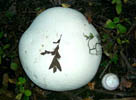(pl. propagules)
Terms discussed: isidium (pl. isidia), soralium (pl. soralia), soredium (pl. soredia)
Topics:
propagule
isidium
soredium
See Also:
Lichen
propagule
A propagule is any part of an organism that can be detached from the organism and disseminated in hopes of it growing into a new biont in a new environment. Sexual spores (ascospores and basidiospores) and the various kinds of conidia are the two most common and well-known types of propagule used by fungi. Except for propagation by dispersal of small, randomly detached mycelial fragments (the only method left to non-yeast fungi that do not produce spores), the methods specific enough to have a name but unusual enough not to get their own entry all belong to lichens.
Back to top
isidium
An isidium is a coral-like, branching structure that breaks off from the main lichen thallus and can grow into a new lichen. It contains cells from both the mycobiont and the photobiont. Because of its relatively large size and weight, an isidium is usually only dispersed a short distance from its parent lichen.
Back to top
soredium
Soredia are tiny balls of one or a few photobiont cells surrounded by fungal tissue. They are usually produced in a powdery mass in a specialized portion of the lichen thalus called a soralium. Because of their relatively small size and weight, soredia are easily dispersed great distances from the parent lichen.
Back to top
Lichens also propagate themselves by bits of the thallus that just break off and hopefully start another lichen somewhere else. I don't think that there's any particular name for this sort of propagule.
Back to top











